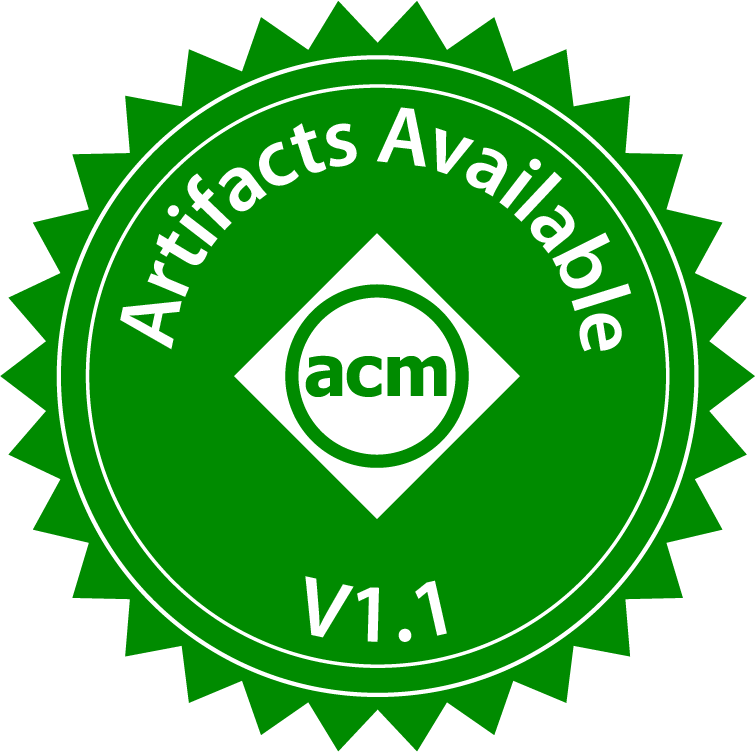Artifact Review Summary: PACTree: A High Performance Persistent Range Index Using PAC
Artifact Details
Badges Awarded
| Artifact Available | Artifact Functional |

|

|
Description of the Artifact
The artifact is available at https://github.com/cosmoss-vt/pactree,
commit 88e6ada507b077f2b8032df3ba61b31379d36733.
In the artifact, the authors provide the source code, the documentation, and an example of the PacTree.
The source code also includes dependencies such as PDL-ART. The README contains the information on how to install, compile and configure the system. The example program can be compiled and executed successfully, and most of the source code match the claims in the paper.
Environments Used for Testing
Evaluations were performed in the following environments:
- Environment 1
- CPU: Intel Xeon Gold 5218R @ 2.10GHz
- Memory: 128GB
- PMem: 512GB (2 x 256GB)
- SSD: 1TB
- OS: CentOS Linux release 8.2.2004 (Core)
- Environment 2
- CPU: Intel Xeon E5-2630
- Memory: 256GB
- OS: CentOS 7 with Linux kernel 4.14
- Environment 3
- CloudLab Instance
- CPU: Intel Xeon Gold 6142
- Memory: 384GB
- OS: Ubuntu 18.04 with Linux kernel 4.15
- Environment 4
- CPU: Intel Silver 4210 @ 2.2GHz
- Memory: 256GB
- Commodity SSDs (non-NVM)
- OS: Arch Linux (5.10.56-1-lts)
- Environment 5
- CPU: Intel Xeon E5-2670 X86 @ 2.3GHz
- Memory: 192GB (12 x 16GB)
- SSD: 256GB
- OS: Ubuntu 18.04.5 with gcc-7.5
Step-By-Step Instructions to Exercise the Artifact
Install dependencies
You can skip this step if CMake is available in your package manager.
- Install CMake
Download latest version from https://cmake.org/download/ $ tar -xvf cmake-your_version.tar.gz $ cd cmake-your-version $ ./bootstrap $ make $ sudo make install - Install other dependencies
# Ubuntu $ sudo apt-get install g++ libtbb-dev libjemalloc-dev libnuma-dev libpmem-dev libpmemobj-dev python zlib1g-dev libboost-dev #Fedora $ sudo yum install cmake make gcc-c++ tbb-devel jemalloc-devel numactl-devel libpmem-devel libpmemobj-devel python3 zlib-devel boost-devel
Get and compile the source code
- Get the source code
git clone https://github.com/cosmoss-vt/pactree.git && cd pactree - Generate NUMA config
bash ./tools/get-numa-config.sh - Create and enter build folder
mkdir build && cd build - Generate Makefile and build the code
cmake .. && make
Set up test environment
- If you have actual NVM
$ sudo mkfs.ext4 -b 4096 -E stride=512 -F /dev/pmem0 $ sudo mount -o dax /dev/pmem0 /mnt/pmem0 $ sudo mkfs.ext4 -b 4096 -E stride=512 -F /dev/pmem1 $ sudo mount -o dax /dev/pmem0 /mnt/pmem1 - If you do not have actual NVM (non-NVM)
- Mount test device to
/mnt - Prepare environment for PacTree
sudo mkdir /mnt/pmem0 sudo chmod 777 /mnt/pmem0 sudo mkdir /mnt/pmem1 sudo chmod 777 /mnt/pmem1
- Mount test device to
- Run example
- Change directory
cd ~/pactree/build/example - Run the example
./pactree-example
- Change directory
How The Artifact Supports The Paper
The artifacts include an implementation of PacTree. Detailed designs in Section 5 in the paper can be found in the source code. The design of PacTree includes two layers: search layer and data layer. The implementations of these layers match the descriptions in the paper. Besides, some auxiliary structures such as the memory management are also contained in the artifact.
Overall, the system can run well and support most of the paper’s claims.
We find a small issue that Section 5.9 of the paper introduces the design of recovery,
but the LinkedList::Recovery function in the artifact is neither implemented nor called.
Most of the source code can be matched with the claims in the paper, and we were able to compile and run the example program. The Functional badge was awarded.